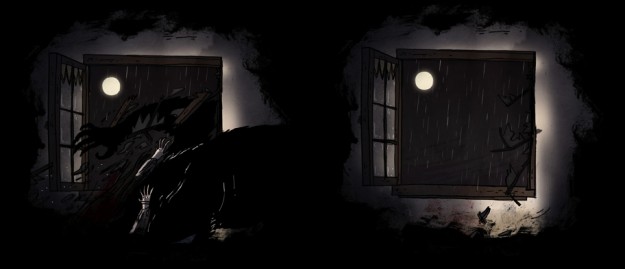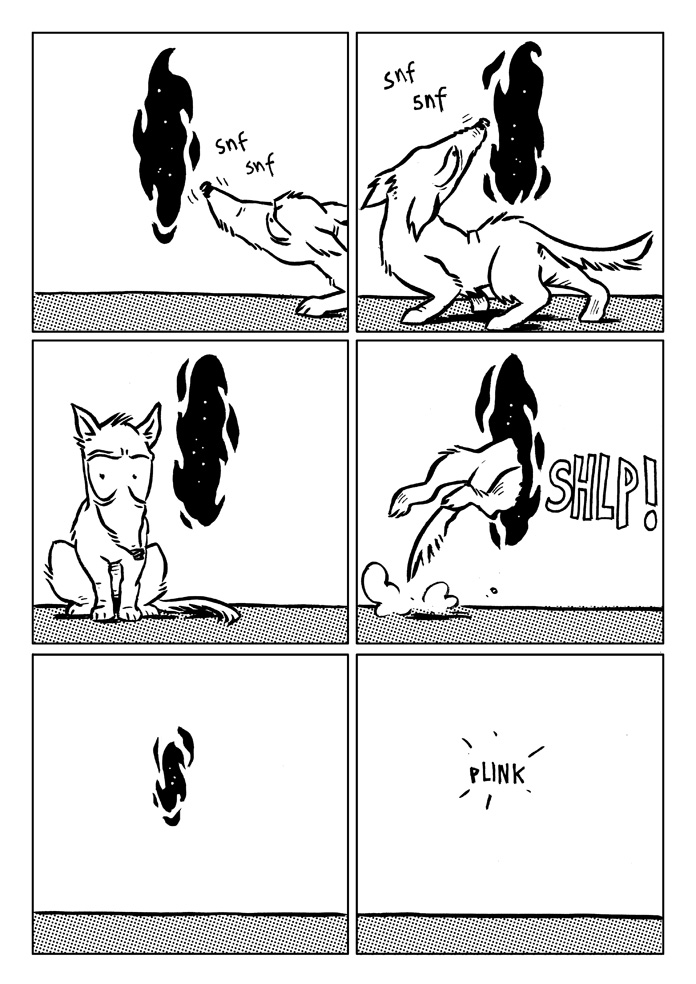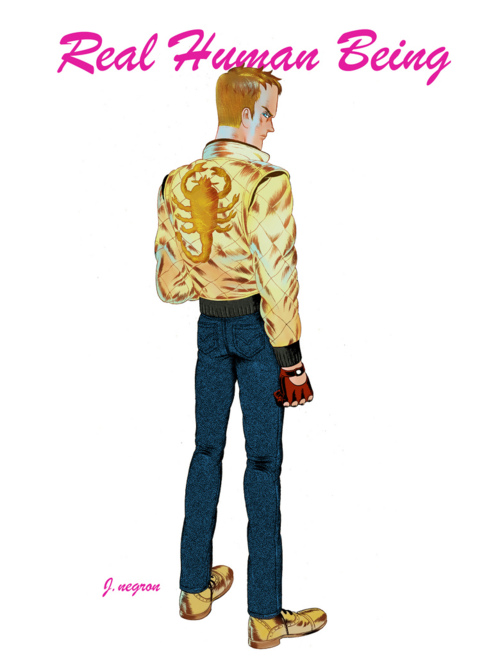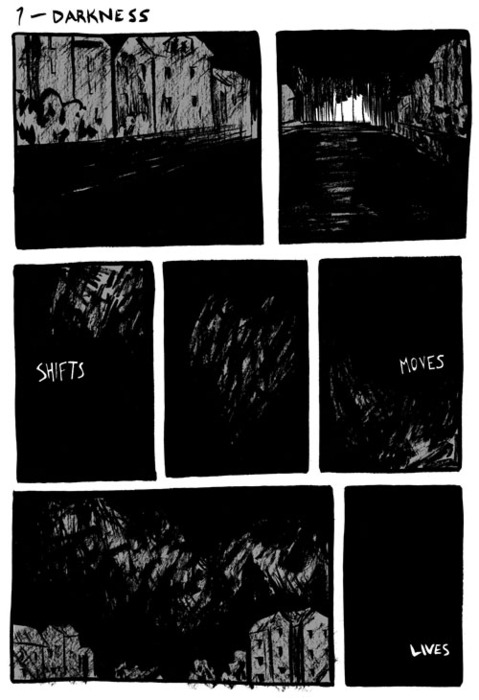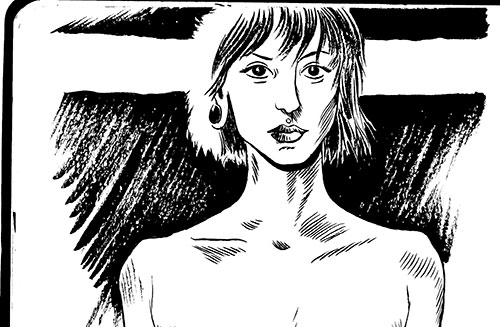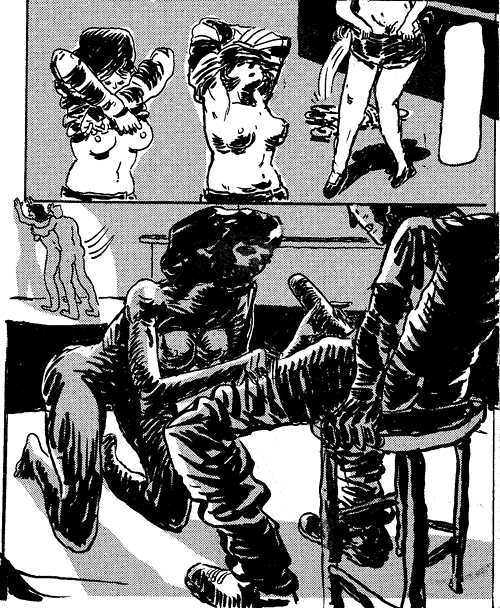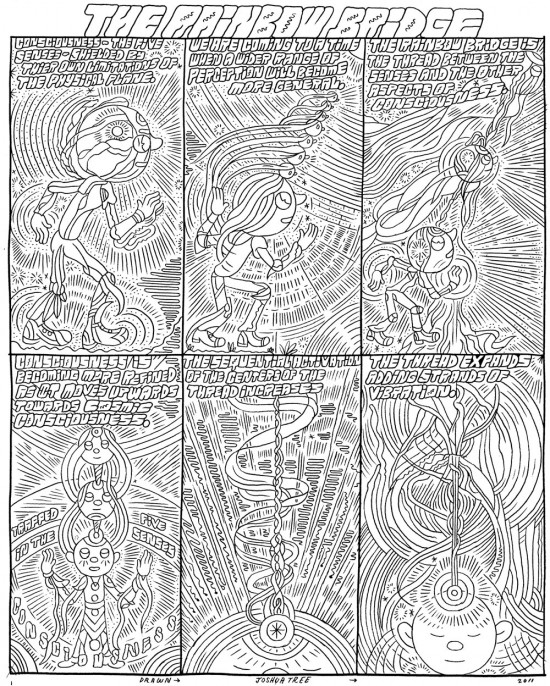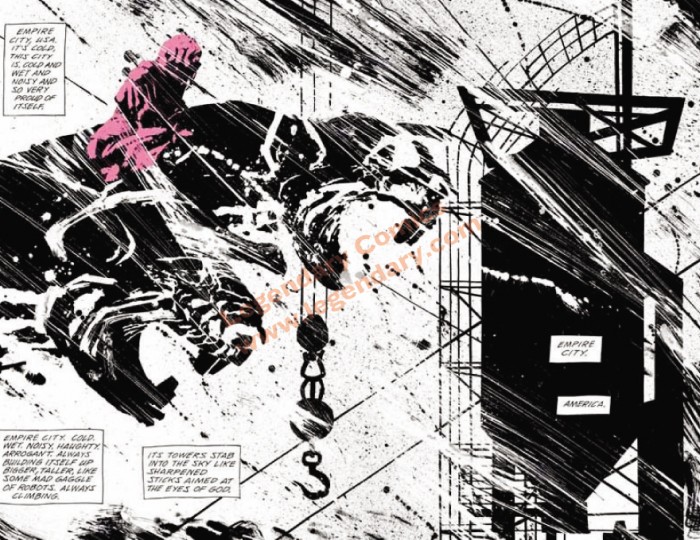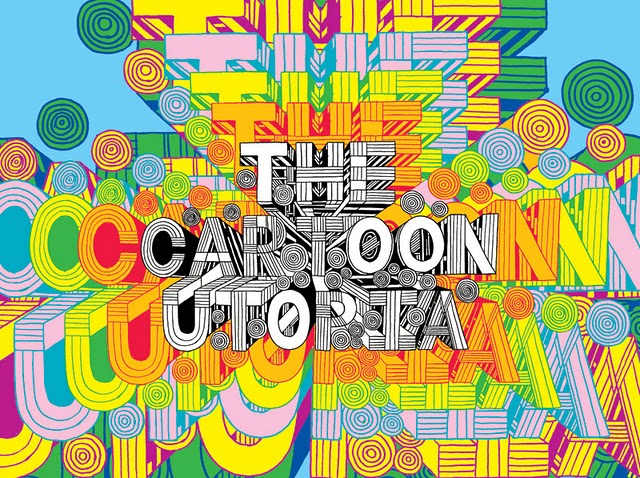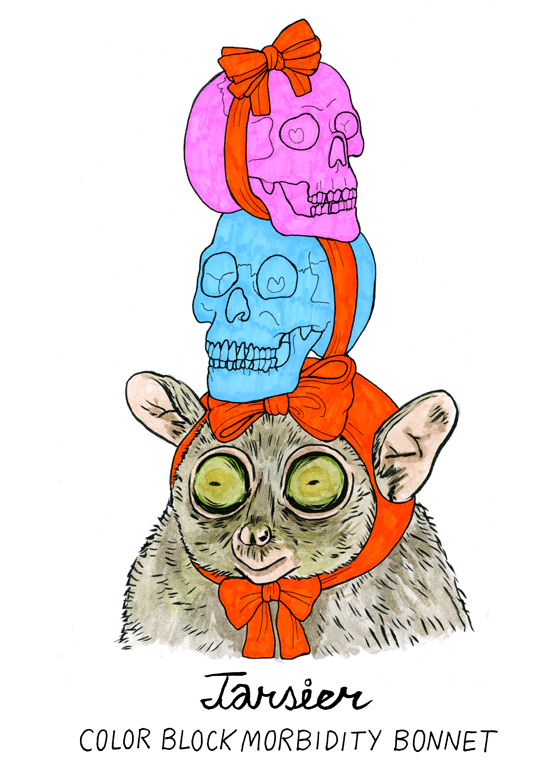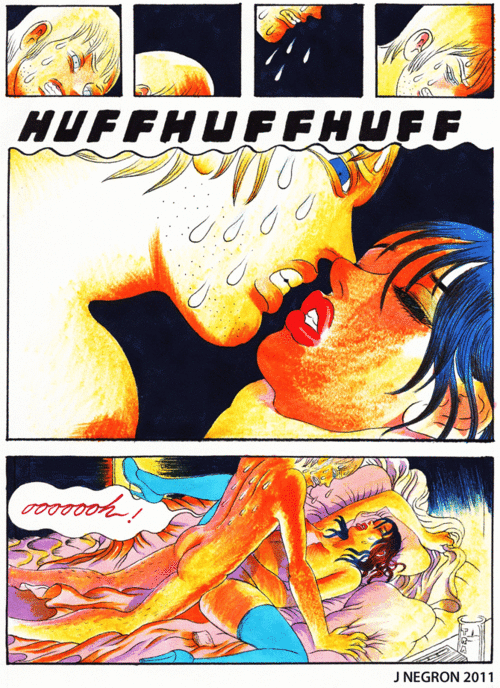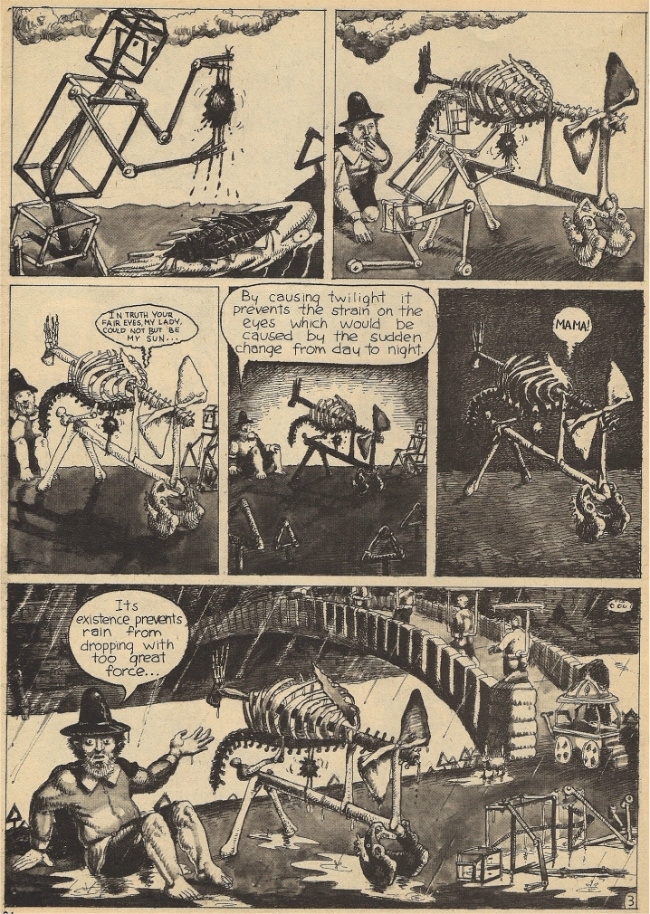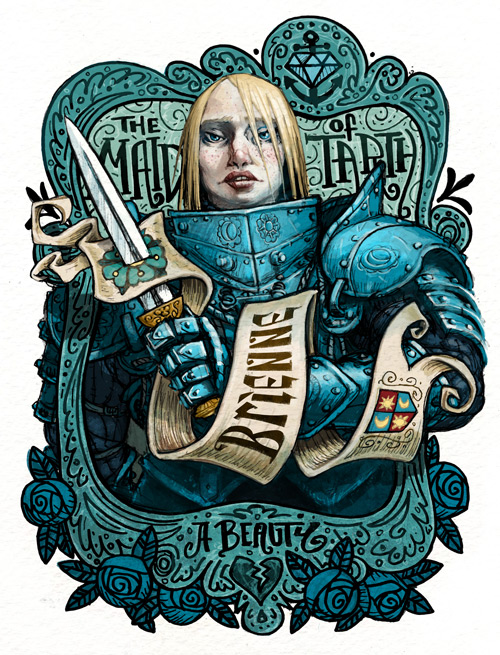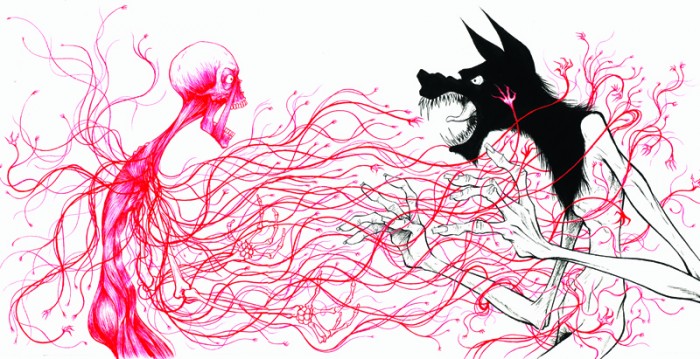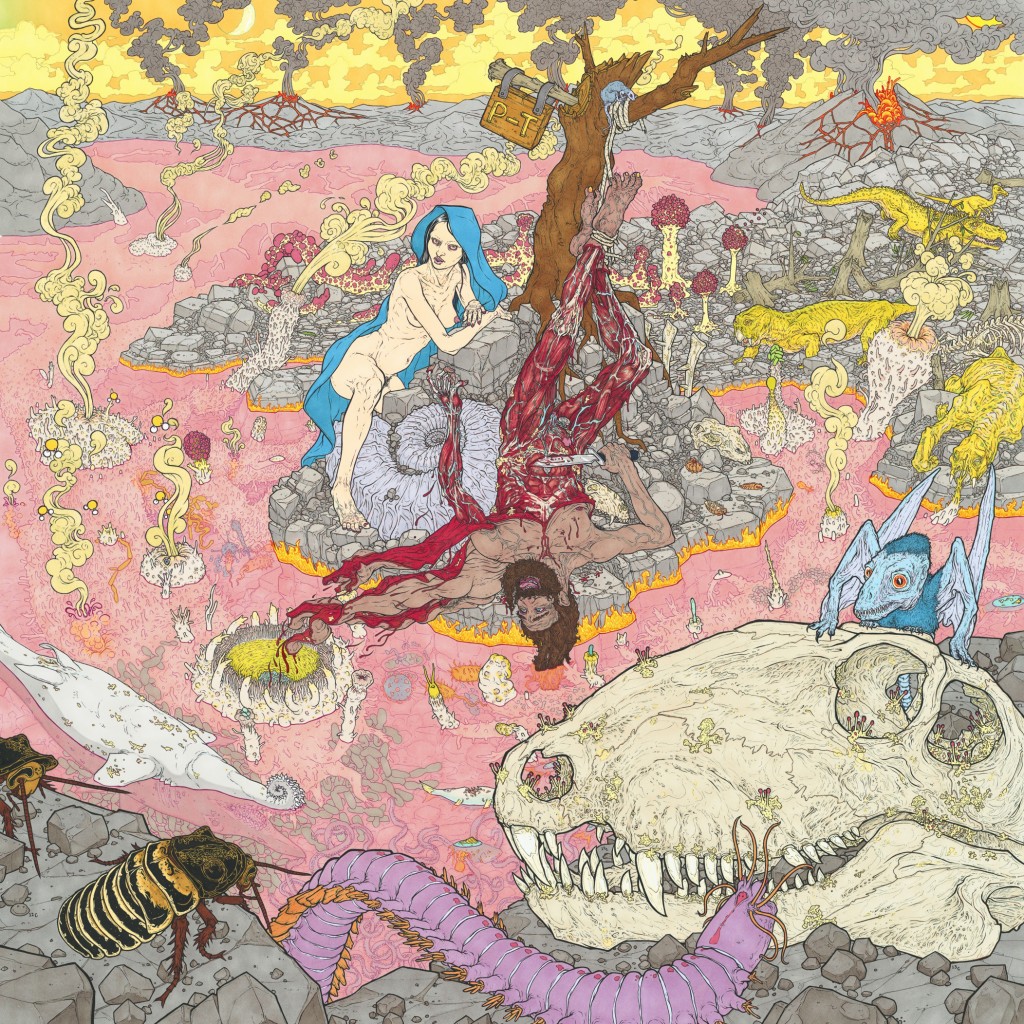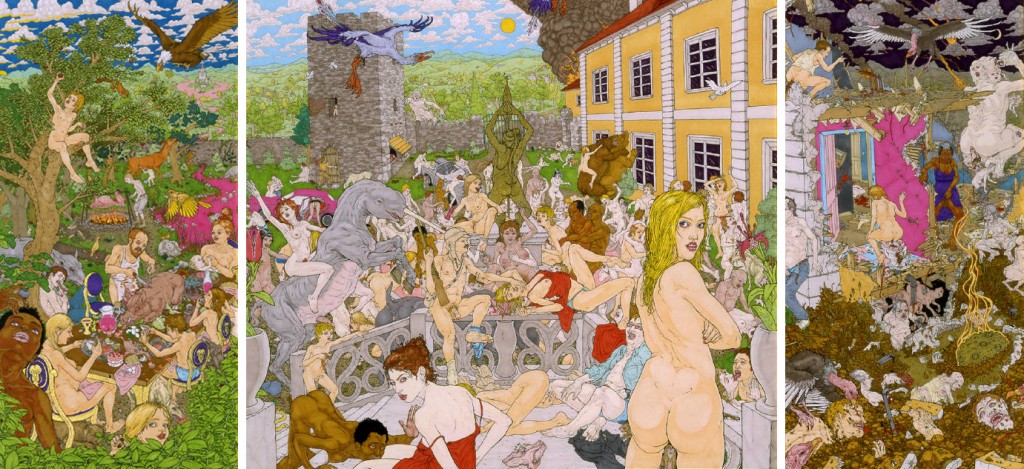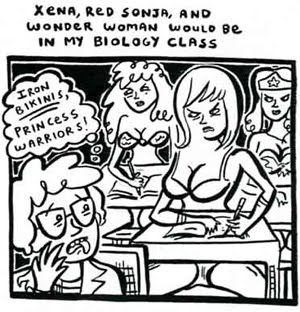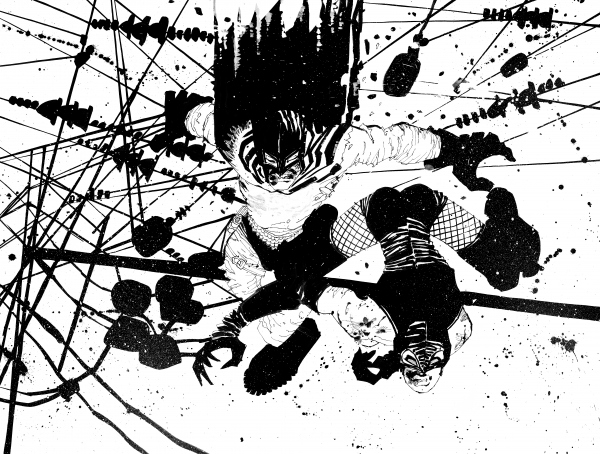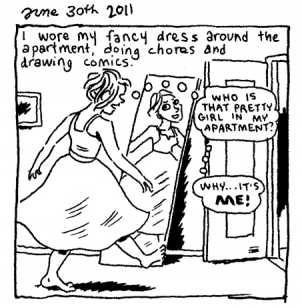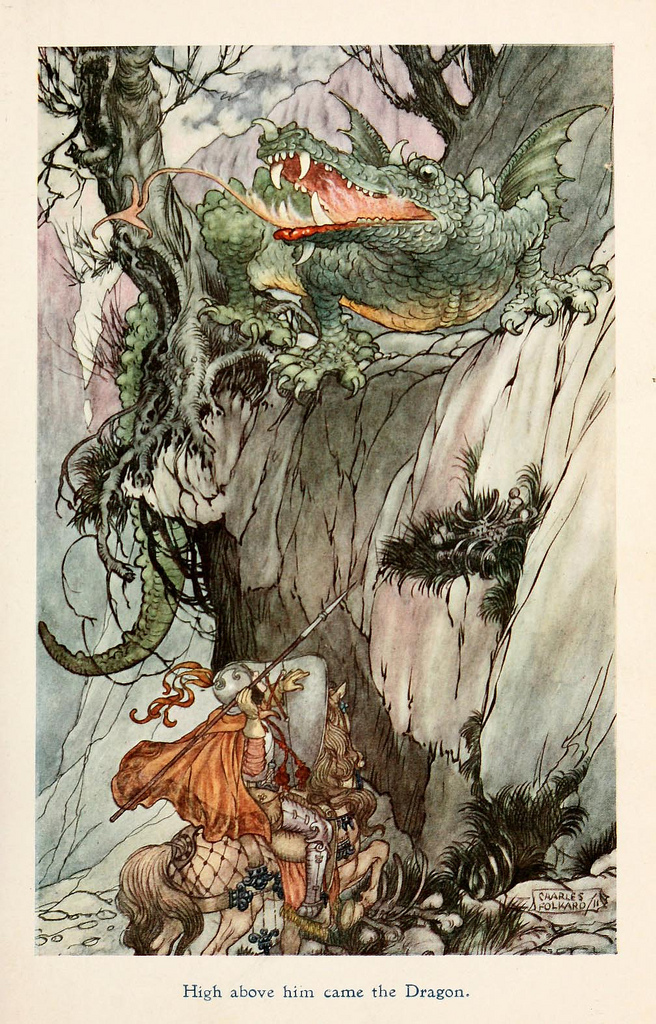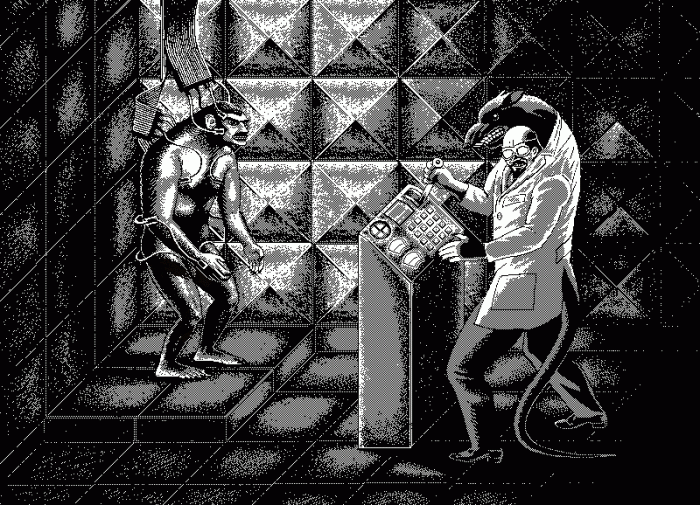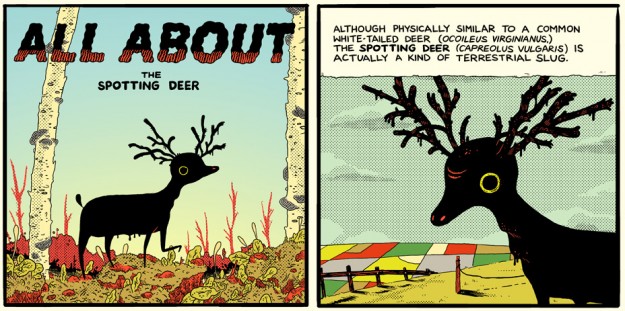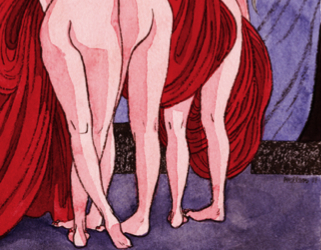Posts Tagged ‘Game of Thrones’
Carnival of souls: Special “Alternative Comics Mount Rushmore” edition
November 2, 2011* Well, this is certainly nice: My comic in Marvel Adventures Spider-Man #19 is getting good reviews from the folks who enjoy Spider-Man comics. Here’s Ray Tate at Comics Bulletin, and here’s David Walton at The Reilly Factor. Kitty’s Pryde liked my page layouts but didn’t like my jokes, which, hey, fair enough. I’m looking forward to seeing if I pass muster with the big Spider-fan sites.
* Oh hey, look, it’s four of the best people in the history of comics. From left: Jaime Hernandez, Gilbert Hernandez, Gary Groth, Phoebe Gloeckner. (Via Peggy Burns.)
* Over at my A Song of Ice and Fire/Game of Thrones blog, I wrote about the role of social justice in the series, using the conclusion of the Harry Potter series as a counterexample. I elaborated on the point for the benefit of a naysayer, too. I realized yesterday just how important this is to me.
* Recently on Robot 6:
*Good god: Gary Groth interviews Robert Crumb at glorious length. I ran down some of the high points for Robot 6.
* Ng Suat Tong annotated all the flashback panels from Jaime Hernandez’s “The Love Bunglers.” I added my two cents at R6 as well.
* Emily Carroll’s “Margot’s Room” has wrapped up. Some lingeringly creepy images in here, as you’d expect.
* And here’s a quick little highlight reel for the Journal’s Habibi roundtable.
* Zack Soto’s Study Group Comic Books, Jason Leivian’s Floating World Comics, and François Vigneult’s Family Style have formed a publishing collective called Press Gang. That’s promising.
* Jesus: The French satire magazine Charlie Hebdo put a caricature of Muhammad on the issue that came out yesterday. Later that day, someone blew up their offices.
* The Minneapolis small press show MIX may be having its last hurrah this weekend.
* David Bordwell’s latest absolute killer of a film essay is on visual density, specifically the way leaving objects that previously played a role in the narrative within the frame charges that frame with memories. The relevance to comics is obvious. And in terms of Bordwell’s recurring themes, he argues that this technique has largely been lost with the primacy of the walk-and-talk/stand-and-deliver binary for shooting dialogue.
* Matt Seneca on recent releases from the great Yuichi Yokoyama. While as usual I disagree with many of his emotional and thematic conclusions — I don’t get pessimism from Garden at all; it seems beyond that to me — I enjoy a lot of his specific observations, like the kindly feeling of the book’s slideshow-style finale. Plus, the piece includes a bunch of gorgeous art from Yokoyama’s thus far untranslated Baby Boom.
* Joe McCulloch on pre-Code horror comics for the Los Angeles Review of Books. Local boy makes good!
* Ta-Nehisi Coates on the increasingly obvious problem with the NYPD.
* Dan White’s latest Cindy & Biscuit story is an all-Biscuit affair. Such vibrant cartooning!
* Michael DeForge previews his next comic, Kid Mafia. I’m detecting a lot of Tim Hensley/Wally Gropius in this one.
* Oh hey, Jonny Negron decided to mint money by offering prints for sale of his Drive pin-up.
* Andrew White appears to be prepping to post a comic every day this month.
* Keep drawing the sessy ladies, Tom Kaczynski.
* More hot stuff from Ryan Cecil Smith. You know, it’s times like these when I wonder if I should put some kind of NSFW tag at the top of the blog, or if it goes without saying.
Carnival of Sean
October 26, 2011* So as you might have heard, I wrote a Spider-Man comic and annotated A Game of Thrones.
* On the latter score, Elio Garcia of Westeros.org has posted his own announcement of the project. Elio calculates that he and I and Anne Groell wrote over 1,000 notes on the book between us, which both surprises me and doesn’t surprise me at all given how into it we all got. I’m telling you, it’s a really rich vein to tap. Elio also notes that Subtext is working on a web version, so you non-iPad users out there, take heart.
* And this was a daymaker: An effusive write-up from big-deal SFF site Tor.com, and one that quotes extensively from me at that. I mean, get a load of this praise:
“this definite guide is interactive, comprehensive, ever-expanding, and most of all, made with the fans in mind….The annotations aren’t idle theories, rather, these are insights from those who know this world better than anyone else in the world, save George R. R. Martin himself.
Who am I to argue?
* My chum Rob Bricken of Topless Robot notes how useful the annotations will be for those readers who can’t tell the players without a scorecard. He also touts our bonafides as experts, which apparently I will never get used to.
* And a special tip of the hat to the Chief, Dan Nadel, who very kindly congratulated me for the project on the blog of the estimable Comics Journal itself.
* As for Spidey, I’d like to thank three of my favorite comicsbloggers, JK Parkin, Tom Spurgeon, and Joe “Jog” McCulloch, for pointing their readers in my comic’s direction. Same for everyone on Twitter and Facebook who’s done so. Thank you all!
* And as noted, I spoke with my co-writer J.M. DeMatteis about all things Spider-Man for CBR.
* Meanwhile, I’m still making my way through Mad Men. Latest post on the end of Season Three here, archive of every MM post so far here.
* As I mentioned earlier, I reviewed Benjamin Marra’s Gangsta Rap Posse #2 for TCJ.com.
* Over at Robot 6, Eddie Campbell, Leela Corman, and I defend Craig Thompson’s Habibi against accusations of Orientalism.
The Annotated A Game of Thrones
October 25, 2011I’m over the moon to be able to finally announce this: I annotated A Game of Thrones.
I didn’t do it alone, either. Working alongside me were Anne Groell, editor of the entire A Song of Ice and Fire series; and Elio Garcia, George R.R. Martin’s go-to researcher, the co-founder (with Linda Antonsson) of ASoIaF megasite Westeros.org, and the co-author (with GRRM and Antonsson) of the forthcoming World of Ice and Fire guide.
I know, right?
We did this in a very cool fashion for a very cool new iPad app called Subtext, which launches today. It’s kind of like having a social network built into the book itself.
The way it works is that you download Subtext for free from the iPad App Store. Then you use it to read any Google Books ebook. As you do so, you can embed notes in the margins at any point throughout the book, sharing your thoughts or asking questions about what you’ve read. You can also read and reply to any notes on the book left by your friends, or in cases like A Game of Thrones, notes left by the author or by experts like, well, me. This video will give you the basic idea.
So in other words, it’s not just that you can read an annotated version of A Game of Thrones — you can annotate it yourself, and interact with anyone else who’s done so, including Anne, Elio, and myself. And a whole bunch of other books featured in the launch have expert or author annotations as well. (George was a bit too busy to contribute himself, which is why we three were tapped. Somehow I don’t think you’ll mind that he didn’t find time in the schedule.)
If you’ve enjoyed my writing about A Song of Ice and Fire here or at All Leather Must Be Boiled or anywhere else, I think you’ll enjoy the notes I’ve left for you to find.
But speaking personally, my contributions kinda pale in insignificance compared to Elio and Anne’s. When I was first approached about the project, I said yes in large part just for the opportunity to work alongside such august personages in the ASoIaF community. I was not disappointed. Anne’s you-are-there anecdotes about discovering the book, working with Martin, and what she knows (and doesn’t know) about what has yet to be written are worth the price of admission alone. (And I’ll tell you what, there’s little that does your superfan ego better than being told by the book’s editor that this or that insight you had about the book was dead on.)
Elio’s astonishingly comprehensive annotations are also more than a return on your investment. He’s provided the first appearance of nearly every character, House, region, and in-world jargon with a capsule biography/definition and a link to further information on his and Linda’s indispensable ASoIaF website, Westeros.org. And as GRRM’s researcher and soon-to-be coauthor, the guy who knows Westeros better than Martin himself, he too offers unique insights into process, theme, and technique.
In both cases, just reading their notes as they went up while I was working on the project was an enormous pleasure. God only knows how much of that AT&T data plan I ate up by anxiously refreshing the Recent Notes page to see if Anne or Elio had dropped any more knowledge bombs on me. And my desire to earn my keep alongside them led, I think, to some of my best ever writing on the book.
I really hope you iPad owners will check it out. Download the app here, then download the book here, then go to town. Our annotations should pop up automatically — keep your eye out for my sigil.
See you in the pages!
PS: Thank you to Elio Garcia for recommending me for the project, thank you to Elio and Anne Groell alike for treating some dude with tumblr like both a peer and a pro, and thank you to Claire Teter from Subtext for guidance and support throughout the process.
Carnival of souls: Frank Miller, Chris Ware, comment-thread discussions, more
September 22, 2011* Some lovely preview pages from Frank Miller’s Holy Terror are going around. (Via Marc-Oliver Frisch.)
* Chris Ware has a new iPad-only comic out. More about this anon.
* Here’s a nice piece by Zom of the Mindless Ones on the end of Twin Peaks.
* George R.R. Martin on early Marvel superhero comics — what made them different, how they influenced him.
* The comment threads for my recent Habibi and Mad Men posts are proving unusually fecund. Check ’em out and talk about Orientalism, competence fantasies, male beauty, and more!
* And hey, how about that Hellen Jo?
Carnival of souls: L. Nichols, Dylan Williams, SPX, more
September 16, 2011* My latest Say Hello! column is up at The Comics Journal. This time I interviewed Jumbly Junkery‘s L. Nichols.
* I’ve collected some powerful tributes to Dylan Williams over at Robot 6.
* I’m pretty bummed that I missed out on getting David Bowie sketches from Craig Thompson and Chester Brown at SPX this past weekend, so you can bet your ass I’m camping out days in advance to get ’em from next year’s guests of honor, Chris Ware and Dan Clowes. The show’s expanding its floorspace next year, which is a good thing — with those two there, they’ll need it.
* Chris Mautner reports on his haul of comics from the show. I too was pleased to see a new Kevin Huizenga minicomic. Speaking frankly, I didn’t feel a lot of energy from that segment of the comics at the show. Most of the stuff I was excited to read, from Big Questions and Habibi to Forming and Pure Pajamas, came from the established publishers. Meanwhile, reliable makers of really good minis like the Closed Caption Comics and Partyka collectives were MIA, and I didn’t really make any discoveries that made up for their absence. It was the one flaw of an otherwise very successful show, I thought.
* Kevin Czapiewski’s con report was an uplifting read. SPX has a well-deserved reputation for being a fun show to hang out with your fellow comics people, but Kevin argues persuasively that this provides not just a pleasant weekend, but a form of creative/spiritual sustenance.
* The Descent director Neil Marshall is directing the pivotal “Blackwater” episode of Game of Thrones Season Two, from a teleplay by George R.R. Martin himself. That’s pretty damn exciting.
* Why did Gabrielle Bell take down her daily diary comics from July?
* Ron Regé Jr. is raising money to help support himself as he completes his next book, Fantagraphics’ The Cartoon Utopia. That’s a gorgeous…cover? Promo image? Gorgeous regardless.
* Lisa Hanawalt has a strange imagination.
* BREAKING: I love Jonny Negron.
All Domains Must Be Registered
September 8, 2011My A Song of Ice and Fire blog All Leather Must Be Boiled now has its own domain: boiledleather.com. Please adjust your bookmarks accordingly.
Carnival of souls: Special “post-outage” edition
August 31, 2011* I wrote a well-received post on feminism and A Song of Ice and Fire over on my ASoIaF tumblr, in response to this pretty bad piece by Sady Doyle and this very good one by Alyssa Rosenberg. Spoilers abound at all three, so be careful. Related, and less spoilery: my big problem with the way the non-Western cultures in A Song of Ice and Fire are portrayed.
* Jeez, the hits just keep on coming in the comics world: The Center for Cartoon Studies’ library was flooded during Hurricane Irene. The books are basically okay, but the building’s screwed.
* On the Sparkplug/Dylan Williams front, Chris Mautner recommends six Sparkplug books you should consider purchasing to a) help out, and b) read great comics.
* And in happier news, this is a terrific idea: The Library of Congress is creating the Small Press Expo Collection, which will permanently archive all of the Ignatz Award nominees and select self-published books and minicomics.
* And if you enjoy alternative comics in the slightest, Rob Clough’s Top 50 Comics of 2010 is well worth your time. You’ll find a lot of the usual suspects on here, and he and I have a lot of overlap, but he orders things in an idiosyncratic way that will make you think about what you liked best and why.
* George Lucas added a bunch more nonsense–and I mean that, it’s nonsense, it’s stuff that it doesn’t really make sense to add–to the Blu-Ray editions of the original Star Wars trilogy. I’m in broad agreement with what Rob Bricken says about this at the link. It’s perfectly fine for George Lucas to do whatever he likes with his movies. He doesn’t owe me anything. It would just be nice if I could own a nice hi-def copy of the movies I loved growing up as they existed when I was growing up.
* Brigid Alverson put together a highlight reel from a recent Dan DiDio/Jim Lee interview about the rebooted DC Universe and its concurrent digital-comics initiative.
* Jeez, Sam Humphries sure knows what he’s doing.
* Zak Smith/Sabbath on what Rem Koolhaas can tell us about Dungeons & Dragons. (Now that’s a tough sentence to top.)
* William Monahan, the guy who adapted The Departed is doing a draft of Frank Miller’s Sin City 2 script. Sure, I’ll eat it.
* Here’s the cover and creator line-up for Thickness #2, the latest issue of Michael DeForge and Ryan Sands’s alt/art smut comics anthology series.
* Both Rolling Stone’s Matthew Perpetua and Pitchfork’s Tom Breihan interviewed the Rapture’s Luke Jenner about his band’s comeback album, and he comes across like a mensch in both. He’s quite candid about why former co-frontman Mattie Safer left the band following his own return to it after he himself quit a few years back, but Safer emerges as a sympathetic figure too. He thought he was now the undisputed leader of the band, and then that was taken away from him. You can easily see how that would weigh on a guy.
* Jonny Negron is a talented person.
* This is what Ben Katchor used to draw like!
* Now and forever the King. (Additional thoughts.)
(A quick programming note: Though a hurricane-related internet outage appears to have resolved itself as mysteriously as it started (on Monday morning, well after the winds from a hurricane during which we never lost power or cable had died down), I’m still having some unrelated computer problems, as well as spending a lot of time writing for other outlets. So if you don’t see me here as often, that’s why.)
Music Time: Jay-Z and Kanye West – Watch the Throne
August 12, 2011Crossposted from All Leather Must Be Boiled.
On Watch the Throne, the new collaborative album by Jay-Z and Kanye West, the title phrase or a variation on it is uttered nine times over the course of sixteen songs. Meanwhile, a recurring orchestral sample — its nervous energy evoking the spooky bits of Magical Mystery Tour, sinister ’60s children’s movies, and the shifty-eyed rhythm of Radiohead’s “Paranoid Android” — shows up in looped form as an unofficial theme at the end or beginning of four separate tracks, including the opener “No Church in the Wild” above.
Did this remind anyone else of George R.R. Martin’s character mantras/catchphrases from A Song of Ice and Fire/Game of Thrones? “If I look back I am lost.” “Where whores go.” “It rhymes with…” “She’s been fucking [names redacted] for all I know…” “Kill the boy.” “You know nothing, Jon Snow.” “Valar Morghulis.” “Weese, Dunsen, Polliver, Raff the Sweetling…” In each of these cases, these are phrases that wounded, worried minds keep circling back and back and back to, obsessively. They’re phrases they cling to and phrases that haunt them.
Can you think of a better way to describe what the the repetition of the words “watch the throne” might mean to two men whose unquestioned position at the top of their field means, as Jay-Z puts it, that the only place they can find an opponent is in the mirror?
I’ve been writing a post comparing Watch the Throne to ASoIaF/GoT since my first listen, but when you play the game of Game of Thrones comparisons, you publish or you perish. Oh well! I actually don’t mind that other people have gotten there first, because it means that the initial, incorrect critical narrative about the album — two rich people rapping about how rich they are, which is bad because of the debt deal and the London riots or something — is falling by the wayside. It’s as if the pressure to turn reviews of an important album around in 24 hours (due to the record’s unexpected, exclusive, leak-thwarting midnight release on iTunes) led critics to forget that anything ever happened at any other time. If it’s not okay to rap about fame and wealth to a struggling audience, then flush the last two decades of hip-hop, including multiple chart-topping critically acclaimed albums by Jay-Z and Kanye West, down the toilet.
But not only is the thesis ridiculous, it’s not even accurate. Obviously Kanye and Jay rap a lot about their money and the stuff they’ve bought with it on this album, and obviously the names they’re dropping are high-end and/or highfalutin’ enough to stand out to critics under deadline pressure. (I bet the Museum of Modern Art didn’t expect to have almost as much of a role on this record as Frank Ocean does.) But you’d almost have to purposefully ignore the rest of the lyrics, and most importantly the sound of the thing, to think that’s all there is to it, to characterize this album as a less forceful-sounding Rick Ross record. For all the talk about life at the top, they seem about as comfortable there as Robert Baratheon, Eddard Stark, and the stained knight Jaime Lannister. The music is foreboding and paranoid, minor-key prog samples, witch house synths, and soul legends chopped and pitch-shifted into demon shouts and banshee wails. The lyrics describe difficulties — from Jay-Z copping to depression, to Kanye’s R. Crumb-like dissections of his sexuality and misogyny, to overcoming the obstacles of a racist society to “make it in America” only to discover that the higher they go, the fewer people like them they find — that go a lot deeper than the usual litany of complaints about haters and biters. Both aspects of the record are embodied by those repetitions — that cycling, recurring, uncomfortable theme music; “watch the throne, watch the throne, watch the throne,” over and over again. If they were comfortable on the damn thing, they wouldn’t constantly be telling themselves and everyone else not to take their eyes off it for a second.
Carnival of souls: DC, DeForge, HBO execs on Game of Thrones, more
July 30, 2011* I’m impressed by DC’s response to the recent debate over the number of women creators it employs. Anyone who says “Well they had to say something, it was bad PR” has obviously not been following the comics industry very long. When you ask someone publicly to do something, and they say “You’re right, we’ll try to do better on that,” that’s a really good thing, especially on an issue like this. Good for DC.
* Grant Morrison in conversation with Neil Gaiman. A fun quote from Gaiman about Morrison: “Whenever I see you now, you are this glorious bird of paradise, but I remember, just as for you I will always be a nervous, hungry young journalist, I remember you as a kid in a black raincoat, incredibly shy. The thing that would get you animated was the point where you’d start talking about a story, and you would come to life.”
* There’s a Marvel/Gary Friedrich lawsuit going on over Ghost Rider right now as well.
* It’s always fun and informative to hear Tom Brevoort talk about how the sausage gets made.
* HBO execs talked about Game of Thrones in a reasonably interesting fashion recently: They’re standing very firm on the 10-episodes-per-season issue, which is unfortunate, but other than that they seem very supportive of a long run and not apt to try to cram too much material (i.e. the entirety of the fatter volumes) into a single season as opposed to spreading it out.
* RoboCop vs. Transformers vs. Hanawalt vs. Harbin.
* Uno Moralez is really one of the best.
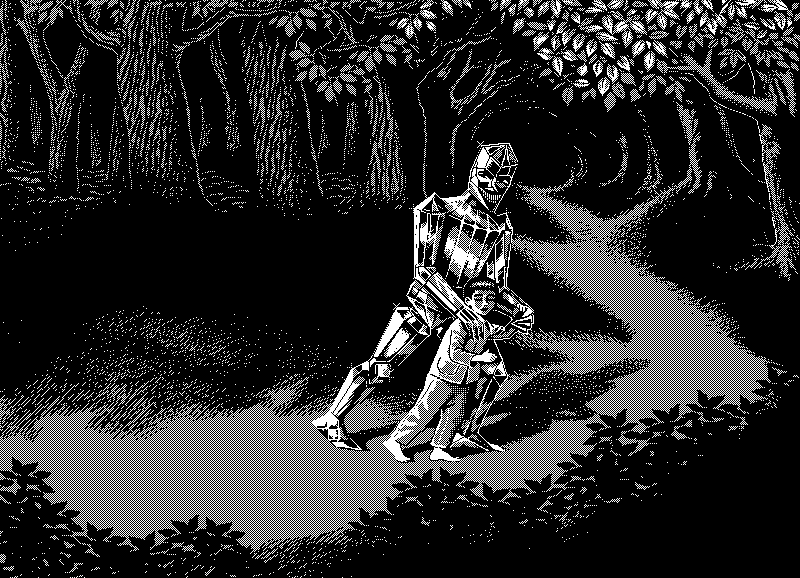
* Funny stuff and sexy stuff from Michael DeForge.
* The Sylvester Stallone Character Name Generator made me laugh very hard. (Via Mike Barthel.)
Carnival of souls: Special “San Diego Comic-Con Days 1&2” edition
July 22, 2011* Here are some highlights from Thursday and early Friday at the San Diego Comic-Con…
* I recommend following Robot 6’s CCI2011 tag for your San Diego news needs. Tom Spurgeon is also keeping a running log of the major comics publishing announcements, with occasional commentary, at his recently revived Comics Reporter site — that’ll be worth checking daily as well.
* Pyongyang/Shenzhen/Burma Chronicles author Guy Delisle’s next travelogue will be Jerusalem: Chronicles from the Holy City, which will take place during the “Operation Cast Lead” Gaza War. That’s something to look forward to, though as I said at Robot 6, it won’t be without controversy. (I’ve already gotten one condemnatory Google Alert hit for that post.)
* Marvel will be releasing day-and-date digital versions of its major Spider-Man and X-Men comics. If you go in for the Marvel Movie Conspiracy Theory, you’ll note that these are the two major franchises that Marvel Studios doesn’t own the rights to, rather than the Avengers and their associated characters. Marvel says they’ll start rolling out same-day digital copies of their other titles at logical jumping-on points, like first issues or the start of major new storylines.
* Sticking with the digital beat, Top Shelf is releasing digital versions of over 70 of its graphic novels.
* Frank Miller’s Holy Terror looks quite entertaining. I hadn’t realized it was in black and white, although I guess with Lynn Varley out of the picture it stands to reason.
* Chris Mautner interviews Brian Ralph about his first-person zombie survival story Daybreak. Fun fact: I have a short piece on this book in the August issue of Maxim!
* In the Friday iteration of DC’s daily panel on its “New 52” linewide relaunch, DC Co-Publisher Dan DiDio said planning for the relaunch began in October 2010, when 23 writers met to talk about the line’s direction. That’s the first firm date I’ve heard — it’s months before most of the speculation I’ve seen has pegged the initiation of the project — and the first time I’ve heard that that many writers were involved.
* In other news…
* I took a quick look at Grant Morrison’s recent comments on Siegel & Shuster’s claim to Superman on Robot 6.
* Speaking of which, Sam Bosma has been doing some extraordinary portraits of ASoIaF characters lately. Spoiler warning: Unless you’ve read the first four books, there are plenty of characters in there you probably haven’t met, so look out.
* Those two links remind me: Things have really been hopping over at my Song of Ice and Fire/Game of Thrones blog All Leather Must Be Boiled since I finished reading A Dance with Dragons. I’ve been posting a lot of commentary and links to interesting art and reviews, and Elio Garcia and Linda Antonsson, the good folks at the big-deal ASoIaF fan site Westeros.org, have been sending a lot of traffic my way, so there’s some good comment-thread action as well. Do check it out if that’s the sort of thing you’re interested in. My review of/braindump on A Dance with Dragons is a good place to start.
* Peter Jackson has released an official composite image of all 13 Dwarves from The Hobbit. Pretty, pretty good.
* Jason Adams runs down the major horror movies slated for release during the back half of 2011, none of which I will get to see, sob sob sob.
Carnival of souls: Special “Back from the Dance” edition
July 18, 2011* I read A Dance with Dragons. I liked it. If you’ve read it, come talk about it with me, artists Matt Wiegle and Sam Bosma, A Song of Ice and Fire superfans/megaexperts Elio & Linda, and other august personages.
* Last week I assembled a massive gallery of great Game of Thrones/A Song of Ice and Fire fanart from around the web for Robot 6. Do check it out; there’s something for everyone, or at least every ASoIaF fan. (This piece is by Rory Phillips.)
* Your top comics story: Peter Laird is discontinuing the Xeric Grants for self-published comics following one final round of grants in May 2012. This is terrible, terrible news. Laird says he’s doing that because digital publishing and digital fundraising have abrogated the need for the Xeric, but I think that’s a massive misreading of a) what kinds of comics are made feasible by webcomics; b) what kind of comics are capable of mounting successful Kickstarter campaigns without having first established a network of contacts in online comics fandom; c) the need North American comics have for one of the few awards that really is a mark of quality (for my money it’s the Xerics, the Ignatzes, and then perhaps the awards given by TCAF and Stumptown). This is going to make things a lot tougher on alternative comics creators — you need look no further than the list of past recipients to see how many noteworthy careers were made possible in part by the Xeric. That’s gone, now. It’s tough to object to Laird’s stated goal of transferring his Teenage Mutant Ninja Turtle millions from funnybooks to actual improving-people’s-lives charities, but I still think the Xerics will be sorely missed.
* Your other top comics story: Borders is dead.
* Your top nerd story: The Dwarves from The Hobbit look awesome. This is a fanmade photoshop of all the pictures released so far, and it fakes Thorin’s body based on the bust shot we’ve been given, but even so, my Hobbit enthusiasm has been officially awakened.
* Kiel Phegley talks to Grant Morrison about his new prose book about superheroes, Supergods. Superlawsuit watchers may want to note Morrison’s take on Siegel & Shuster.
* Marvel’s Tom Brevoort on what DC does and doesn’t do well: part one, part two. I doubt that many people reading this blog are Marvel or DC partisans, as is the case for the audience of those posts at Robot 6, so maybe you’ll be better capable of seeing just what a gift we readers of superhero comics have in a high-profile top-level editor who’s willing to say what he thinks about most anything, and can do so articulately and with ideas he’s actually thought through over the course of years in the industry, as opposed to regurgitating PR talking points. This is very, very, very rare.
* Speaking of Brevoort, he addresses a complaint I’ve had myself: Though all of his story has been told in Ed Brubaker’s Captain America series, Bucky’s death was relegated to Matt Fraction’s Fear Itself. Brevoort says Brubaker has written an epilogue one-shot that will address the death in the context of his excellent Cap run, which is good news.
* Flannery O’Connor: The Cartoons. ‘Nuff said!
* The hardcover for Jesse Moynihan’s Forming Vol. 1 looks terrific.
* Dan White has launched a new Cindy & Biscuit website at Mindless Ones. I like that comic quite a bit.
* Paul Karasik reviews Joyce Farmer’s Special Exits for The Comics Journal. You, whoever you are, ought to read that book.
* Jeffrey Brown of Clumsy and Incredible Change-Bots fame wrote the upcoming wedding comedy Save the Date starring Allison Brie and Lizzy Caplan. That is just wonderful.
* Whoa, NeilAlien resurfaced! It’s like I’ve died and gone to earlier in 2011.
* I’ll admit it, I love this kind of crazy collector’s project: DC is releasing a $150, 1,216-page DC Comics: The New 52 hardcover containing all 52 first issues from its September relaunch. Speaking of which: Ch-ch-ch-ch-changes! (Cf.) Elsewhere, Toronto’s The Beguiling comic shop is selling all 52 issues for a bundled price of $104; that strikes me as a great idea for retailers.
* Can you imagine getting a letter of praise from a master of your art like the letter Jim Woodring sent Hans Rickheit? Man oh man.
* Jonny Negron’s sexiest illustration, now in color!
* My collaborator Isaac Moylan sure can draw.
* I’m always up for a good look at James Cameron’s Aliens, a film that’s as good at what it does as any I can think of. This one comes courtesy of Edward Copeland.
* David Lynch made an animated video for Interpol’s very good song “Lights” called “I Touch a Red Button.” It’s like an exercise in how much creepy intensity he can wring out of four or five frames. He’s very good at making horrible faces, that’s for sure.
* Wow, watching this attempt to beat Super Mario Bros. with the lowest score possible without saving or cheating made for some pulse-pounding viewing. I was literally cringing and jumping in my seat. The Hammer Brothers sequence is like the 8-bit equivalent of the stairs of Khazad-Dûm.
A Dance with Dragons thoughts
July 18, 2011I’ve posted an ADwD braindump — likely the first of many — on my A Song of Ice and Fire blog, All Leather Must Be Boiled. Needless to say, SPOILER ALERT.
Blog closed on account of dragons
July 12, 2011A brief programming note: Blogging will be very light until I finish reading A Dance with Dragons. I will not be using Twitter at all during this time, and will likely stay away from Tumblr and the bulk of the Internet as well. Thank you for your patience, and I’ll see you on the other side.
Carnival of souls: Tom Neely, Mat Brown, Dave Kiersh, Frank Miller, more
July 5, 2011* I’m very excited to direct you to my interview with Tom Neely about his new graphic novel The Wolf, which includes a selection of preview pages. The book is Tom’s best, and one of the best of the year.
* When was the last time you were truly amazed by an artist you’d just seen for the first time? For me it was my discovery via Monster Brains of Mat Brown. This stuff is incredible — like the Sistine Chapel painted by an Alien facehugger attached to Geof Darrow. Click through to see it at full size.
I mean, seriously.
* Whoa: Dave Kiersh has an entire blog dedicated to posting his early minicomics in their entirety. My favorites so far are 1998-99’s Quaaludes, 1999’s Young Adult, and 2003’s Amazons, none of which I’ve seen before despite being a fairly dedicated Dave K. fan. It’s amazing to think he hit his teenage-heartbreak sweet spot when he pretty much was a teenager.
* Mmmm, hot licks from Holy Terror by Frank Miller.
* George R.R. Martin’s A Song of Ice and Fire occupies four of the top ten New York Times paperback best sellers right now, including #1. Don’t click the list unless you want the shit spoiled out of books three and four, though.
* Is it just me, or are the Harvey Award nominees better than the Eisner Award nominees this year? Like, insofar as they actually nominated Acme Novelty Library #20 and Love & Rockets: New Stories #3?
* Gabrielle Bell will be posting a diary comic every day for the month of July. Good news for people who like to see new Bell.
* The Comics Grid’s Kathleen Dunley takes a close look at the overabundance of information in the truly horrifying torture sequence from Brian Chippendale’s Ninja. I’d forgotten how difficult that page was to take.
* I’m actually not nuts about the posts in practice — they feel a bit underbaked, a bit too dependent on the reader sharing certain assumptions about and impressions of any given song — but in theory, the music blog One Week One Band spending seven days talking about David Bowie’s 1990s work (with writer Ian McDuffie) is an exciting prospect to me, since that’s the first David Bowie I knew. Like Tori Amos, Aphex Twin, Pantera, Pink Floyd, Marilyn Manson, Gary Numan, and Joy Division, I got into David Bowie because Trent Reznor was into David Bowie. Earthling was my first Bowie record, and it’s still one of my favorites. It’s so loud!
* Better in practice is Matt Zoller Seitz’s list of The 10 Loudest Movies Ever!! It’s basically seven films that are varying degrees of wonderful and then three piles of shit.
* Uno Moralez’s random
image/gif gallery posts are really the best bang for your internet buck. Please click the link — if you haven’t seen one of these things, you can’t understand.

* This is almost anticlimactic after the earlier Mat Brown link, but Monster Brains’ Charles James Folkard gallery is lovely as well. Aeron Alfrey’s really been on a hot streak at that site lately.
* Tom Brevoort gives good interview.
Nostalgia is powerful and potent, and it’s one of the things, particularly for the longtime audience, that makes things go. If you can drop in a reference or do a twist or bounce some story point off a comic we fondly remember, we as an audience like it. It works for us. It rewards the investment in the material and the time spent, and it creates a larger sense of involvement than is typically possible in a single TV show or a movie or a novel. It’s one of the things that comics can do with their serial storytelling style that many other forms of entertainment can’t. The danger there is that if you rely on it too much, you’re telling stories only for people who have been reading for 30 years or who are willing to put in the hard work to understand whatever it is you’re talking about – the particular language you’re speaking. That’s the balancing act.
* It’s hard out here for a cartoonist: Theo Ellsworth edition.
* Best of luck to my old Wizard coworker Rick Marshall as he departs MTV’s Splash Page blog.
* Film and culture historian Robert Sklar has died, rather tragically. A part of me will always be a Film Studies student, and that part is very saddened by this.
Playing a Game of Thrones: Why you should read George R.R. Martin’s A Song of Ice and Fire series
June 22, 2011Regular readers of this blog are no doubt aware (to say the least!) that I am a big fan of George R.R. Martin’s series of fantasy novels called A Song of Ice and Fire, and that I’m eagerly anticipating the HBO series adapting them, called Game of Thrones. But a few days ago I realized that you might not know why. Credit for this goes to my blogging chum Curt Purcell, who used the occasion of my umpty-millionth post on the topic to ask:
Without giving too much away, can you maybe hit a few bullet-points about what sets SONG OF ICE AND FIRE apart from other similar fantasy series? It sounds so run-of-the-mill, even when people gush about it. What am I missing that would make me want to read it?
As I said in the comment I left to answer his questions, I’m such an enthusiast for this material that I don’t know if I’ll be any good at expressing or explaining why. (I’m also emotionally and physically exhausted due to all sorts of off-blog goings-on this past week and am not at my most cogent.) But I’ll take a shot at running down some of the series’ distinguishing characteristics. Sit back, relax, and enjoy the hard sell.
First off, what exactly are we talking about here? Well, as I said, A Song of Ice and Fire is a series of epic fantasy novels by writer George R.R. Martin, whom some comic fans and nerds may know from his involvement with the Wild Cards series of revisionist-superhero prose novels, or for his time on the writing staff for the Ron Perlman/Linda Hamilton Beauty and the Beast TV show. So far, four volumes of a (sort-of^) planned seven have been released: A Game of Thrones, A Clash of Kings, A Storm of Swords, and A Feast for Crows. The HBO series, spearheaded by David Benioff and Dan Weiss, takes its title (sans indefinite article) from the first volume and will debut on April 17; the plan is to adapt one book per season, although the books get so long that some may need to be spread over the course of two seasons.
What’s the setting? Without spoiling anything important, here goes: The books take place mostly in a land called Westeros, your basic roughly medieval-European epic fantasy setting, albeit one with far, far fewer overt trappings of fantasy than, say The Lord of the Rings — humans are the only game in town in terms of races, and we’re several generations removed from the last time magic/sorcery or mythical creatures like dragons were a going concern. The main fantastical feature when the story begins is how the flow of seasons work: Summer and winter can each last for years, decades even, before shifting unpredictably.
Westeros, which ranges from an arctic climate up north to a Mediterranean one down south and has similar cultural lines of demarcation, was once divided up into Seven Kingdoms, each ruled by great families, or Houses. But for centuries now, the whole continent has been united under one ruling King. However, about 15 years or so before the story begins, a group of powerful Houses banded together to overthrow the current king, who had gone insane, thus ending the kingdom’s first and up until that point only dynasty.
What’s the story about? Again, without spoiling anything important: It’s 15 years after Mad King Aerys of House Targaryen was overthrown by an alliance of nobles who were either burned by his cruelty or hungry for power of their own, or some combination thereof. The leader of the alliance, Robert Baratheon, has been king ever since, supported by his wife’s hugely influential, hugely assholish family, House Lannister. But when his mentor and right-hand man dies (or is murdered — no one’s really sure), Robert, who seems well-intentioned but by now is kind of a drunk and glutton and horndog and not a very good king, heads north to seek the help of his best friend, Eddard Stark, who has command of the kingdom’s distinctly unglamorous northernmost area. A Game of Thrones primarily chronicles the conflicts between House Stark and House Lannister as Ned, as he’s known to his friends, tries to help out King Robert and get to the bottom of the mystery of their mutual mentor’s death, and some other shady goings-on as well.
But meanwhile, two threats are brewing beyond the kingdom’s borders and outside the struggle for power and influence surrounding the rival Houses. The first lies in the uncivilized wastelands to the North, beyond a massive Great Wall of China-type structure called The Wall, a 700-foot-tall barrier made totally of ice that stretches from sea to sea. Thousands of years ago some kind of supernatural menace came out of the North to threaten the Seven Kingdoms, and the Wall was constructed after mankind’s victory to keep the threat from coming back. By now it’s been so long that the organization tasked with maintaining the wall is a neglected, ragtag band, ill-prepared for…whatever it is that seems to be going on out there, somewhere.
The other lies overseas, where the only two survivors of the overthrow of House Targaryen, a boy named Viserys and a girl named Danaerys, have hit their teenage years and are trying to mount a comeback. Even though Aerys was a major creep, and Viserys is no great shakes either, if the two of them get the right backers and the right soldiers, they could present a major threat to the new rulers of their old kingdom, who know they’re out there but have no idea how to find them.
Why should I care about any of this? This is really the heart of Curt’s question, and probably yours, if you have a question about the series yourself. Chances are you either are perfectly conversant and comfortable with the standard tropes of fantasy and thus this series’ specific iterations thereof aren’t enough to hook you, or you’re the sort of person who automatically tunes out anytime someone in a tunic whips out a sword and says “I am Aragorn son of Arathorn, heir to the throne of Gondor” or somesuch and thus you’re skeptical that the books would be for you even if they’re the best gosh-darn stories about a made-up kingdom of knights and dragons and shit ever invented. With all of you in mind, I put together a list of what sets the books apart, both for me and, from what I’ve gathered based on talking to and reading about other fans, for a lot of people. This is the stuff that matters.
1) I mentioned this already, but it bears repeating: The fantasy elements are surprisingly minimal, particularly at first. Simply put, if you’re the kind of person who can’t stand elves and orcs and dwarves and wise old wizards, they won’t be around to turn you off out of hand. Now, this wasn’t really a selling point for me, since I’m a person who has the White Tree of Gondor tattooed on my left arm and obviously has no preexisting, in-principle problem with elves and orcs and dwarves and things of that nature. But I think you’d be surprised at how little high/epic fantasy I’ve actually read outside of The Lord of the Rings. The vast majority of my fantasy reading was done when I was a YA reader, and was centered either on satires (Piers Anthony’s Xanth books, Robert Asprin’s Myth series) or sort of off-model, less Tolkienian series (this is the stuff I remember more fondly — Susan Cooper’s The Dark Is Rising Sequence, Ursula K. LeGuin’s Earthsea trilogy, and Lloyd Alexander’s Prydain Chronicles, the most Tolkienian of the group but still pretty far removed from the Elves/Dwarves/Orcs model that dominates much of the genre)). In my mind, I’d come to associate stuff that more directly bore the fingerprints of Professor T or his Gygaxian reinterpreters with either unoriginality, tedium, or cheese. So a series that focused more on character and worldbuilding in the cultural and historical senses of that word than on invented races or bestiaries or magical systems was perfect for me when deciding to give fantasy another try at age thirtysomething.
2) A closely related point: In the absence of magical stuff, the story’s driven by realistic human conflicts. Martin has said that the series’ central struggle for power — the titular game of thrones played by various important people we meet — was inspired by England’s real-world War of the Roses, with its complex web of family loyalties and regional rivalries and so on. In terms of narrative fiction, I think the the closest comparison is The Godfather and The Godfather Part II. A Game of Thrones combines the first film’s story of rival families violently jockeying for supremacy amid all sorts of complex conspiracies and alliances with the second film’s story of the very serious, very smart leader of one of those families trying to uncover the origin of a plot against him and his. The point is that we’re very far from rote Joseph Campbell hero’s-journey fantasy storytelling, with some dude learning it’s his destiny to defeat the Dark Lord. If you’re sick of that sort of thing, you’ll find a lot more to hook you here. This goes double if you’re the sort of person who’s ever enjoyed fictional or non-fictional war epics or gangster stories. “The Sopranos with swords” really is a pretty dead-on way to describe what’s going on here.
3) Another reason “The Sopranos with swords” works, and probably one of the big reasons HBO bit: There’s graphic language, violence, and sex. Again, I’m not particularly well-read in the genre, but this is something I’ve really never seen before, not outside weirdo projects like CF’s Powr Mastrs — and this isn’t some cult-favorite alternative comic series, it’s the most popular and influential contemporary fantasy series other than Robert Jordan’s Wheel of Time. If you’re the sort of person who’s complained that Tolkien’s world is too sexless and bloodless to really care about, believe me, you won’t be voicing similar complaints here. I’ll elaborate on this a bit below, but I also would argue strongly against the notion that any of this is shock for shock’s sake, or rote revisionism. It’s simply Martin writing fantasy the way other writers would write about any other world full of human beings who kill each other and have sex and get pissed off. It’s refreshing. “Deadwood with swords” works here.
4) One last related point: The story isn’t just set in a (relatively) realistic world, driven by realistic human conflicts, and featuring realistic human behavior — it’s powered by relatable human relationships, emotions, drives, desires, and even mistakes. I’ve written about this at length before in somewhat spoilery fashion, but to recap it here, so much of what happens in these books hinges on the personal relationships between the characters, and the way old grudges or old friendships cloud judgment and lead to poor decisions. Perfectly well-intentioned, innately noble characters can’t stand other perfectly well-intentioned, innately noble characters for various reasons that are all too familiar — long-ago affairs, half-forgotten insults, petty jealousies. Characters will know full well that their family is a collection of really awful people, but they’ll still do their level best to help out because hey, it’s family, and it’s psychologically and emotionally tough as hell to leave your family behind. In other words, like all of the best HBO shows did with their respective genres — The Sopranos with the mafia, Deadwood with Westerns, The Wire with cop shows — A Song of Ice and Fire isn’t just surface revisionism, it’s bringing the full weight of richness of literary fiction to genre entertainment.
5) Moving on, here’s a point about the basic logistics of reading these books: The structure of the narrative is highly addictive. Each chapter focuses on a particular character, whose name serves as that chapter’s title, and the characters rotate throughout the book(s). This has the effect of embroiling you in a particular character’s situation or storyline, then immediately popping you over into another’s, so that you find yourself racing through the chapters to get to the next one starring the person you’re interested in — and then getting interested in the ones you’re reading in the interim, and repeating the process over and over. It’s rather brilliant.
6) The raw plot is enormously engrossing. There’s a dynastic struggle that encompasses a murder mystery, a conspiracy, shifting and secret alliances, political machinations — and then brewing underneath it all, two major external threats. You find yourself wanting almost desperately to get to the bottom of it all, and Martin is a strong enough writer to keep adding elements without drowning out the ones that hooked you in the first place. A good comparison here might be Lost, where each time you hit the ground level of the until-then central strain of antagonism, the creators yanked the rug out and revealed another beneath it. The shape and scope of the story is perpetually enriching and expanding.
7) I think Martin’s a pretty strong prose craftsman. There are a few groaners in there, especially in the first book (I think there are two warm fires in the hearth that couldn’t chase away the coldness in Character X and Y’s hearts, for example), but let’s just say that my dayjob sees a lot of SF/F pass across my desk and some of it is embarrassingly badly written. Martin knows his way around the typewriter.
8.) Big surprises, as shocking and powerful as any I’ve read or seen in any work of narrative fiction ever. Stuff that’s on the level of all-time gut-punches like “I did it thirty-five minutes ago” or “You are the dead” (or for you altcomix readers, the big moments in ACME Novelty Library #20 or Love & Rockets: New Stories #3). You want to stay as spoiler-free as possible about these books, that’s all I’ll say. Like, if you start reading them, don’t even read the back-cover or inside-flap blurbs. (Seriously, DON’T.) This is not to say that if you know the surprises, you won’t enjoy the books — I knew one of ‘em and still loved it, just like I knew all of the major deaths in The Sopranos through Season Four and still loved it — but man oh man. There’s one part that had me so stunned and upset I literally lost sleep over it, and sat there rereading the chapter, sure I must have missed something or somehow gotten what I’d read wrong. I didn’t. It was awesome.
9) This is hard to articulate without spoiling the grand arcs of the narrative, but suffice it to say that having read all four currently existing volumes, Martin is playing an impressively long game. I don’t want to say too much more, but when you’ve read enough to start getting a sense of where it may head in the final three volumes, it’s kind of stunning in scope. Seeds planted in the first volume are carefully cultivated and tended to for multiple books and multiple years and multiple thousands of pages and still haven’t blossomed yet. Best of all, I think this all ties to one of the central themes of the series, but again, I don’t want to spoil anything.
10) This one’s important: There’s basically nothing glorious or badass whatsoever about violence as portrayed in these books. Most great fantasies don’t skimp on the emotional consequences of being enmeshed in these great struggles — the scouring of the Shire and Frodo’s departure are obviously the beating heart of The Lord of the Rings just for starters — but I don’t think I’ve ever read a heroic fiction that so relentlessly drives home how war and violence immiserate and degrade everyone who participates in them. There’s a haunting flashback in the first volume that in other hands would have been a depiction of some great and glorious last stand, but Martin imbues it so thoroughly with a sense of great sadness and loss and waste and terror. It’s beautiful and really humanistic. Now, I know Tom Spurgeon, who’s no dummy, disagrees with me on how the violence in the book comes across — he thinks it’s Mark Millar’s Ultimate Lord of the Rings, not because he feels Martin is glib or crass or glorifying the violence, mind you, but simply because he feels the use of violence is primarily calculated to get the material over with maximum genre-tweaking impact — but as he’ll also tell you, he’s in a very small minority on this. Martin, as it turns out, was a conscientious objector during the Vietnam War; I know that doesn’t necessarily reveal a fundamental truth about him beyond “he really didn’t want to go to Vietnam,” but in reading these books, I think his draft board made the right call.
11) That said, when there is action and violence, it’s really strong and really heart-pounding. And when there is fantasy, it’s exciting and strange and awesome, in the original sense of the word. The reason why is the same in both cases: We know that in this world, both swordplay and the supernatural have irrevocable, terrible, life-changing, world-altering consequences.
In short (haha, yeah right), I’m about to say something that I pretty much never say, even about works I deeply love and even to readers whose tastes I feel I understand deeply: I recommend these books without hesitation or qualification. And I’ve done so to readers ranging from my Destructor compadre Matt Wiegle to the fiftysomething mother of two grown children who works in the cubicle next to me, all of whom are basically over the moon for them. If you look into ASoIaF fandom at all, you’ll find this story repeated over and over: Fantasy skeptic gets enthusiastic recommendation from trusted friend, says “What the hell, I’ll give it fifty pages,” and within hours is passing on enthusiastic recommendations of their own. Consider this mine.
^ Why the “sort of”? The series was originally envisioned as a trilogy, but it grew to four volumes and then to six as Martin wrote the initial volumes. When he hit the writing process for the fourth book, he realized the amount of material he wanted to cover would require the book to be split in half even just as a logistical matter, so the series is now slated seven books long. This decision, plus his decision to scrap a planned “five-year jump” for the story between volumes three and four and his subsequent need to re-write and re-conceive a lot of existing work, led to a lengthy delay between A Storm of Swords and A Feast for Crows and a positively infamous delay between Crows and the planned fifth volume, A Dance with Dragons. Martin seemed to have planned to announce a publication date for Dragons during the TCA press tour last week, but an illness around Christmastime sideswiped him; still, I expect an announcement on the book before or when the HBO series debuts in April.
Carnival of souls: Brian Chippendale on Marvel, Kim Thompson on Tardi/Manchette, the Big Man, more
June 20, 2011* My final Game of Thrones chat with Megan Morse is now up at The Cool Kids Table. I’d say this one’s most interesting for our talk of different approaches to season finales, and what was expected here versus what was delivered.
* Brian Chippendale is back writing about Marvel comics! Nobody does it better. He’s absolutely right that Uncanny X-Force is a really good book, by the way. Also, Brian Chippendale is on Twitter.
* Kim Thompson interviews himself about the new Jacques Tardi/Jean-Patrick Manchette book Like a Sniper Lining Up His Shot. I really don’t like the sound of what he says about cat lovers beware.
* Over at Topless Robot, my pal Rob Bricken has some fun at Green Lantern‘s expense. As he and I have both said before, you can put up with almost any number of plot holes of whatever width provided the stuff those holes were poked in was worthwhile to begin with.
* John Porcellino’s King-Cat #69 is now up on What Things Do. I liked that issue.
* New Ben Katchor is always a delight.
* Uno Moralez is great update: Uno Moralez is great.
* I haven’t been following Hans Rickheit’s Ectopiary; this page tells me I ought to get on that toot sweet.
* And how about that Moebius?
* Finally, I will miss Clarence Clemons, who helped make this.
Game of Thrones thoughts index
June 20, 2011Here are links to all of my Game of Thrones reviews. I’ve added the special features I’ve written for Rolling Stone to the list chronologically, so that once you’ve read the preceding review post, it’s safe to read that feature as well. I hope you enjoy them!
SEASON ONE
Episode 01: Winter Is Coming
Episode 02: The Kingsroad
Episode 03: Lord Snow
Episode 04: Cripples, Bastards, and Broken Things
Episode 05: The Wolf and the Lion
Episode 06: A Golden Crown
Episode 07: You Win or You Die
Episode 08: The Pointy End
Episode 09: Baelor
Episode 10: Fire and Blood
List: The Seven Most Awful Things People Did on Game of Thrones Season One
SEASON TWO
Episode 11: The North Remembers
Episode 12: The Night Lands
Episode 13: What Is Dead May Never Die
Episode 14: Garden of Bones
Episode 15: The Ghost of Harrenhal
Episode 16: The Old Gods and the New
Episode 17: A Man Without Honor
List: The 10 Biggest Differences Between Game of Thrones and the Books
Episode 18: The Prince of Winterfell
Episode 19: Blackwater
Episode 20: Valar Morghulis
* Follow-up 01
* Follow-up 02
List: The Best and Worst New Characters in Game of Thrones Season Two
List: Final Standings in the Game of Thrones After Season Two
SEASON THREE
Q&A: Bryan Cogman (Executive Story Editor)
Season Three Cheat Sheet
Season Three New Character Guide
Episode 21: “Valar Dohaeris”
Q&A: Natalie Dormer (Margaery Tyrell)
Episode 22: “Dark Wings, Dark Words”
Q&A: Sophie Turner (Sansa Stark)
Episode 23: “Walk of Punishment”
Q&A: Nikolaj Coster-Waldau (Jaime Lannister)
Episode 24: “And Now His Watch Is Ended”
Q&A: Alfie Allen (Theon Greyjoy)
Episode 25: “Kissed by Fire”
Q&A: Maisie Williams (Arya Stark)
Episode 26: “The Climb”
Q&A: Aiden Gillen (Petyr “Littlefinger” Baelish)
Episode 27: “The Bear and the Maiden Fair”
Episode 28: “Second Sons”
Q&A: Gwendoline Christie (Brienne of Tarth)
Episode 29: “The Rains of Castamere”
Q&A: Richard Madden (Robb Stark)
Taking stock of Season Three: Bloggingheads.tv discussion with Alyssa Rosenberg
Episode 30: “Mhysa”
SEASON FOUR
The Top 40 Game of Thrones Characters, Ranked
Season Four Cheat Sheet
Q&A: Pedro Pascal (Prince Oberyn Martell)
Episode 31: “Two Swords”
Q&A: Rory McCann (Sandor Clegane/The Hound)
Episode 32: “The Lion and the Rose”
Episode 33: “Breaker of Chains”
Episode 33 extra: on “that scene”
Q&A: Aiden Gillen (Petyr Baelish/Littlefinger)
Episode 34: “Oathkeeper”
Episode 34 extra: more on “that scene” and its aftermath
Episode 35: “The First of His Name”
Episode 36: “The Laws of Gods and Men”
Episode 37: “Mockingbird”
Episode 38: “The Mountain and the Viper”
Episode 39: “The Watchers on the Wall”
Q&A: Neil Marshall (director, “The Watchers on the Wall,” “Blackwater”)
Episode 40: “The Children”
The Top 10 Greatest Moments from Game of Thrones Season Four
Carnival of souls: Retrofit, Matt Zoller Seitz on Game of Thrones, Tom Brevoort on pitching, more
June 17, 2011* Box Brown is starting a Kickstarter-funded line of pamphlet-format alternative comic books called Retrofit, by an array of names you’ll recognize. I increasingly feel that the real competition for this sort of work isn’t graphic novels but the Internet, but either way, it’s a worthwhile endeavor.
* Matt Zoller Seitz proclaims Game of Thrones Season One one of the best first seasons of television of all time. As a fanboy of both entities, I was almost inappropriately delighted to read this. I think Seitz is likely right that the show will improve on repeat viewing once you’ve seen the whole run so far.
* I think that if you’ve read interviews with comparable figures from the superhero comics industry, you may have a better sense of why I appreciate Tom Brevoort’s interviews as much as I do. This one focuses on how Marvel goes about crafting new series: whether they stem from a niche that needs filling or an idea that grows organically, whether they’re generated from within by editorial, from outside by a writer with a pitch, or from some combination thereof.
* If you ever wanted to read Michael DeForge’s excellent comic Spotting Deer online for free, well, now you can.
* Kristy Valenti reviews Jess Fink’s sexy sex comic Chester 5000 XYV, which in addition to being fun was a comic I found surprisingly provocative in an unexpected way.
* Hey, Kate Beaton works blue!
* Speaking of naked lady drawings, I assure you you want to click through and see this entire Hellen Jo illustration. She’s a talent.
* The cover for Esperanza, the latest Jaime Hernandez Love and Rockets digest, is one of the series’ most appealing so far.
* Go buy some original art from Paul Pope! I’ll wait.
* The Beast of Busco has long been once of my favorite cryptids.
Sellsword update
June 15, 2011I contributed an essay recommending A Song of Ice and Fire for the latest issue of The Lifted Brow, the fine Australian arts magazine. To put on my other nerd hat for a moment, there’s also comics and art from the likes of Blaise Larmee, Lane Milburn, Noel Freibert, Lisa Hanwalt, and Eddie Campbell. You should check it out.
Also, my weekly Game of Thrones chat with Megan Morse is up at The Cool Kids Table. This one ends on a high note.
Game of Thrones thoughts: Season One, Episode Nine – NON-SPOILERY EDITION
June 13, 2011SPOILERS FOR THE SHOW, NO SPOILERS FOR THE BOOKS – if you haven’t read the books, you can still read this . Crossposted from the spoilery edition at All Leather Must Be Boiled.
* That was tough to watch. Who knew? Maybe months of anticipating what would happen in this episode were enough to recreate a week of wondering what would happen in this episode. By that final scene my pulse was racing, and I had that elevator-dropped-out feeling in my stomach I’d grown familiar with from The Sopranos, Deadwood, The Wire, Battlestar Galactica, and Lost, shows that at one point or another had me convinced that anyone, literally anyone, might not make it to the end of a given episode. Only this time, I knew, and still got that feeling.
* It was the show’s best scene as filmmaking, certainly. Sweeping camera movements to create a sense of immersion and environment, intelligent sound design that highlighted or dropped this or that element to hyperfocus our attention, terrific performances from Sophie Turner and Maisie Williams and Sean Bean. Even little details, like how Joffrey was framed when he ordered the execution, or the way Ser Ilyn Payne just materialized out of nowhere, slapped on his mask, and brought the sword down, delivered.
* You’re primed to think the big question is “Will Ned sacrifice his honor or die?”, not “Will Ned sacrifice his honor and die?” The misdirection goes well beyond “they’ll never kill the main character…will they?” and into how the whole back half of the season/book is constructed.
* Jeez, the Hound is huge. Did you see him holding Ned on the steps when Ned got beaned by the crowd? He towered over Sean Bean.
* And speaking of sound design, the sounds from Drogo’s tent…woof, that was good stuff. I actually think this was a more frightening way to approach it than the scary shadows of the book. It’s actually more of a challenge to make a tent feel like a mouth into hell in broad daylight, but those horrible bellows and screams were more than enough. I wouldn’t have gone in there.
* I’m glad to see Varys’s motives being revealed and treated as sincere. Even Ned seems to get that. Conleth Hill was especially good in that scene, every bit the practiced liar finally letting his guard down and delivering some real talk.
* Michelle Fairley continues to improve as Catelyn. Her anger and frustration with Walder Frey’s pettiness and her tears of joy upon seeing Robb return from battle were her two most human displays in the whole series. Catelyn’s our main character now, for all intents and purposes, and this episode made me a lot more optimistic about that prospect.
* Tyrion’s sleepover party with Bronn and Shae was a blast. You’ve got to hand it to Jerome Flynn and Sibel Kikelli, who took two characters we barely know, including one we just met, sat them alongside a main character played by a beloved actor, and made it feel like yeah, absolutely these three people would stay up into the wee hours drinking and goofing around together. I’m a softie, so I’m happy anytime characters in fiction about how hard the world is manage to respect and befriend one another.
* Just a lot of fine moments sprinkled throughout the whole episode, actually. Sticking Tyrion on the dolly for that shot as he comes to was inspired, just as discombobulating as you’d imagine it was for Tyrion. Maester Aemon comes out of nowhere to reveal that he’s one of the most important people in the world. Jon’s fellow grunts flip out over his sword like the teenage boys they are, while Rast and his fellow raper sit in the corner glowering. It was a really, really good hour of television, good enough to get me too keyed up to sleep properly.
* I’ve long said it’s a mug’s game for people like me to try to speak for viewers who’ve never read the books, but I do wonder what they made of this episode’s two major battles taking place off-screen. Since I’ve been following the production of the show from day one, I was aware that budget limitations constrained them from going too crazy in the battle department, but I did expect that they’d get at least one in before the season was over, and it stood to reason that Tyrion riding into battle at the front of a horde of screaming tribesmen was going to be the one. Instead he got clocked on the head and slept through the battle. While this was certainly true to the material’s penchant for puncturing the glory balloon and letting all the air seep out, it also felt like what it was — a way to save money. Ditto Robb’s victory in the Whispering Wood, despite it being presented in much the same off-screen way it was in the book. Since the show isn’t wedded to the book’s POV-character structure, it’s show itself to be perfectly capable of showing us what was going on when our POVs were elsewhere. Robb Stark’s direwolf-aided sneak attack on Jaime Lannister would be a logical choice in that regard, you’d think. It’s a testament to the filmmakers that this episode felt as epic and portentous as it did even though both battles were presented as a fait accompli.
* And boy, there’s nothing quite like feeling disappointed about the lack of battle scenes to make you question if you’ve truly internalized A Song of Ice and Fire’s anti-war message as much as you’d thought. I think I’m okay with my desire to see a good battle scene despite my growing (and ASoIaF-aided!) pacifism — after all, it is okay to enjoy things in art you’d never enjoy in real life. Certainly someone as apt to freak out over animal cruelty as I am had to come to grips with that fact if I were to watch the show at all. But more than that — and here I credit Maureen Ryan, who’s been something of a killjoy about the show, for the insight — A Song of Ice and Fire is a series about war, and it’s tough to be about war without showing war. I still think the message gets through thanks to all the other horrible killings we’ve seen, but seasons down the line, things like Septon Meribald’s monologue about broken men are going to have less of an impact if we’ve never seen why men might break. Or maybe I just want some exciting and thrilling carnage. Maybe it’s both.



